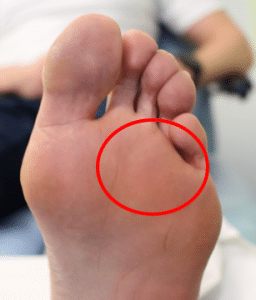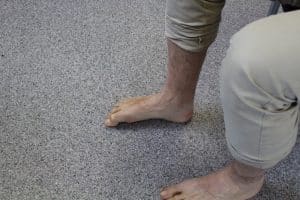What is a Neuroma?
A neuroma is when a nerve in the front of the foot becomes irritated and enlarged.
A neuroma is when a nerve in the front of the foot becomes irritated and enlarged.
A neuroma is thought to be caused crowding of the forefoot. This might be a tighter shoe at the toe box or activity that might be putting increased pressure on the feet. An increase in weight can contribute to symptoms flaring. As we age our foot posture tends to spread and get wider, due to ligament changes. It’s important to adjust your footwear needs to foot shape changes.

Pain, numbness, burning, and tingling sensations are the main symptoms. This can be described as the feeling of walking on a pebble with pressure of the forefoot to the ground. Numbness and tingling may extend to the toes.
If you have put on weight or are considered over-weight than this might be impacting your foot symptoms. Eating a healthy diet or following a weight loss programme might help reduce your foot pain in the long term.
See our “Healthy Living” section for more information on local healthy weight services
A reduction in impact activities might help reduce your symptoms or even simply wearing a cushioned shoe around the house, as pressure can be an aggravator.
Wide fitting shoes are recommended to help reduce squeezing of the foot and aggravation of the nerve. Slip on shoes, tighter toe box, stiff materials around the bunion are not going to help if your neuroma foot pain. A decent cushioned sole shoe/trainer that is not easily compressed under the ball of the foot is important. See footwear advice
Over the counter painkillers like paracetamol or ibuprofen will ease the pain, but need to be taken regularly in order to control the pain. Follow the instructions on the packet and discuss using them safely with a pharmacist or GP, especially if you have any underlying health conditions.
https://www.nhs.uk/medicines/paracetamol-for-adults/
https://www.nhs.uk/medicines/ibuprofen-for-adults/
Adding cushioning under the ball of the foot can help with symptoms these are known as metatarsal straps. A metatarsal strap/sleeve goes over the front of the foot offering gel padding for comfort.
Pro11 Gel Metatarsal Pads – ShoeInsoles.co.uk
Pro11 Ball of Foot Fabric Support with Gel Pad (Pair) – ShoeInsoles.co.uk
Metatarsal Pads/domes (made out of foam or fabric) can also be stuck onto the insole inside your shoes. These pads are often stuck just behind the ball of the foot to deflect pressure and splay the foot. These can work well for many neuroma cases but for some patients they find the pad awkward object under the foot and a cushioning is preferred.
Pedag T Form Metatarsal Supports – ShoeInsoles.co.uk
Pedag Drop Metatarsal Supports – ShoeInsoles.co.uk
Podotech Polyurethane Metatarsal Pads – ShoeInsoles.co.uk
Basic Metatarsal Domes – ShoeInsoles.co.uk
metatarsal dome placement – how to do it your self – YouTube
The aim of these foot exercises is to help reduce symptoms by mobilising the forefoot joints and strengthening foot muscles to provide stability when you are putting weight on the front of your foot.


If you have tight calf muscles then stretching these will help reduce pressure on the front of the foot when walking.
If you prefer to stretch your calf muscles whilst seated, you can use a towel or a belt to stretch your calf muscle.
Steroid injections can relieve inflammation in some patients which helps reduce the symptoms. There is a limitation on injections as can cause damage to the surrounding tissues with over-use.
Neuroma surgery is only recommended as a last resort, once non-operative treatment measures have been exhausted and if your symptoms remain significant. In most cases the operation is performed under a local anaesthetic. A neurectomy is surgery that involves the removal of the problematic nerve and then the surrounding tissues are often released.
There are risks to foot and ankle surgery
Off-work There will be a requirement to elevate your foot and rest non weight bearing then semi weight bearing.
Swelling and Stiffness- The foot can swell as a response to surgery and as part of the healing process. It can take up to six months for swelling to completely settle in some cases. Although in some cases post-surgery there may be increased stiffness in the foot.
Infection- The act of surgery is invasive which is also a risk to infection. In some cases, this can delay healing and will require antibiotic treatment.
Bloods Clots- A small risk of developing a blood clot after foot surgery. Following the pre and post operative advice will help reduce this risk.
Numbness- Can exist in the surgical site in the web space due to the removal of the nerve in this region.
Persistent Pain Some patients have persistent pain post-surgery or the symptoms may return. This can be because the nerve becomes problematic further in the foot.
Chronic Regional Pain Syndrome Surgery can sometimes result in a swollen, painful and highly sensitive foot. This can be challenging to manage and often patients will be referred to the pain clinic for support.
Criteria Based Access
In Bristol, North Somerset and South Gloucestershire neuroma surgery falls under the criteria-based access (CBA) Forefoot surgery policy. Therefore, you must have exhausted and evidenced the conservative treatment options available. A consultation with a foot and ankle specialist can help discuss the treatment you have been doing and what further options are recommended. Funding for surgery will be considered if the problem is causing pain or severe functional impairment and treatment has been exhausted.
Contact your general practice if you need further help and guidance, a referral to local musculoskeletal services is required in some instances, and they can advise on appropriate treatment or pathways suitable to you.
Back to Foot & Ankle